
God in Creation Part 4 – THE EVIDENCE OF GEOLOGY
HOW OLD IS IT?

THE THEORY OF evolution is inextricably linked with the geological record, for in the various layers of rock are found fossils that allegedly show a development from simpler forms of life. These sedimentary rocks consist of water-laid deposits which, according to the uniformitarian theory (i.e. that these deposits were formed by processes similar to those that are going on today) were slowly laid down over millions of years.
Many readers will have heard of some of the names and dates given to these various rock strata that girdle the earth. For example, geologists give the term Carboniferous to a sixty-five million-year period; commencing two hundred and eighty million years ago, during which the forests flourished that supposedly gave rise to present-day coal deposits. The Cambrian age (said to be 570 million years ago) describes rocks that contain the earliest traces of animals.
THE GEOLOGIC COLUMN
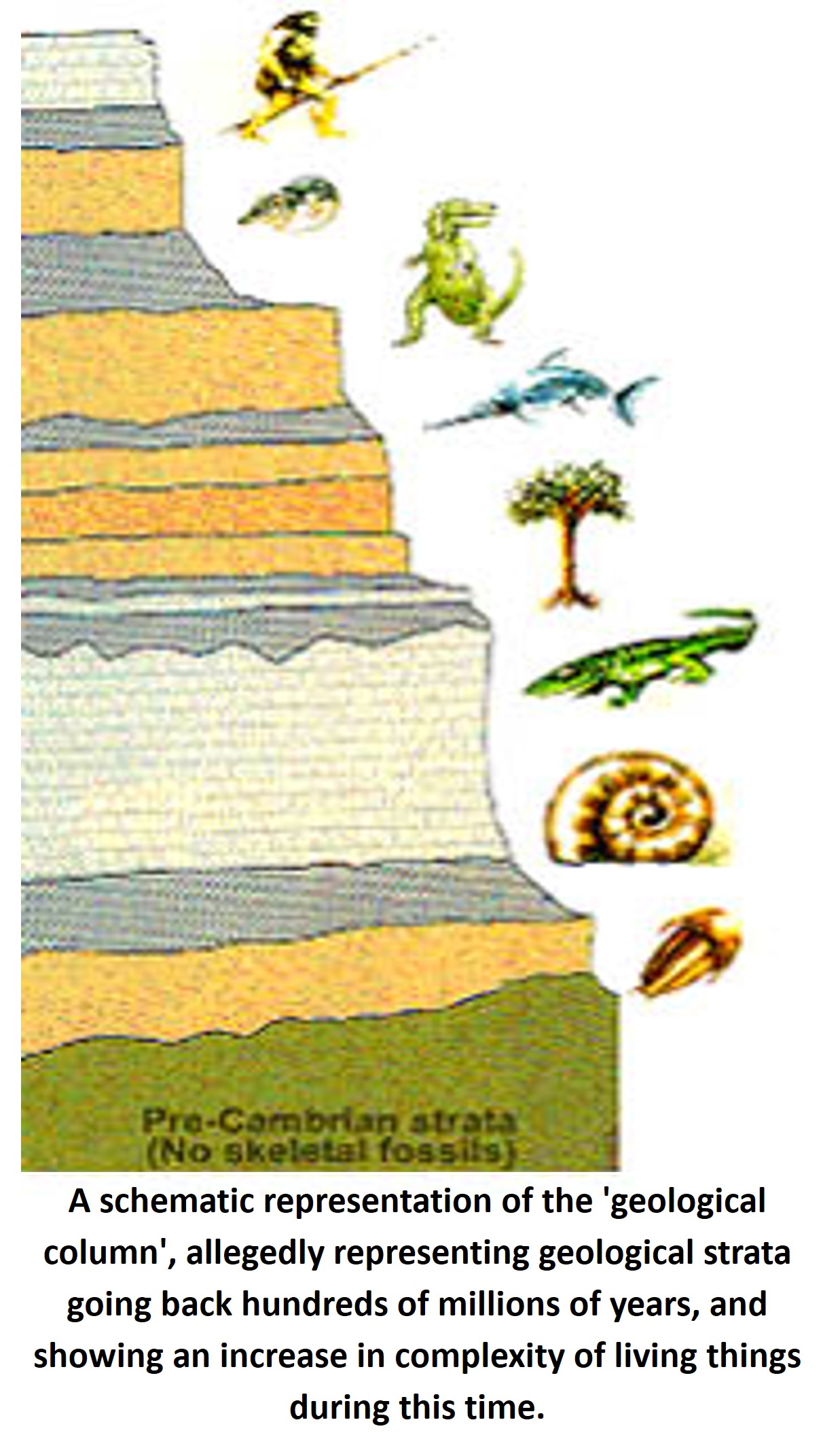
By collating rocks from various parts of the world, an imaginary geologic column has been built up, with the oldest rocks at the bottom and the youngest at the top.
Evolutionists claim that when this column is examined from bottom to top, the fossils in it show a gradual development from simpler to more complex forms of life.
This all sounds very convincing – but how do they know the age of the various rocks, so as to be able to place them in an order of increasing age?
The simple answer is that in general, they have been dated by the fossils they contain. If the fossils are ‘primitive’, then the rock is old and if more complex, the rock is younger and so on. Therefore based on the fossils they contain, the rocks are dated and put into an ascending order of age.
Then evolutionists say – ‘Look, the simplest fossils are at the bottom and the more complex ones at the top – that’s proof of evolution.’ In other words, they date the rocks on the assumption that evolution is a fact and having done that say that the rock sequence proves evolution to be correct.
CIRCULAR REASONING
This is not misrepresenting the situation. One writer says: ‘If a geologist wished to date a rock stratum he asked an evolutionist’s opinion on the fossils it contained. If an evolutionist were having difficulty dating a fossil species, he would turn to the geologist for help. Fossils were used to date rocks: rocks were used to date fossils.’ 25
This example of circular reasoning is probably not detected by the general public but it has long contained a valid objection, with implications for Darwinian evolution. For example, one critic says: ‘Here is obviously a powerful system of circular reasoning. Fossils are used as the only key for placing rocks in chronological order. The criterion for assigning fossils to specific places in that chronology is the assumed evolutionary progression of life; the assumed evolutionary progression is based on the fossil record so constructed. The main evidence for evolution is the assumption of evolution! Consequently there is certainly no real proof that the vast evolutionary time scale is valid at all…Here is one of the most classic and subtle examples of circular reasoning in all the complex history of metaphysical opposition to Biblical creationism.’ 26
An American physician also writes: ‘Any honest geologist will admit that … the age of geologic strata or the dating of fossils, are frequently the result of ‘circular thinking’ and, as such, have an inherent potential for significant error.’ 27
References
25 R. Milton: The Facts of life, 4th edition page 43 (Corgi Books 1992).
26 Scientific Creationism pages 136,229 (Creation-Life Publishers, 1977).
27 W.F. Duerfeldt: Ohio University, Hospital Practice, 1981
DATING ROCKS – SOME PROBLEMS

What about the more recent methods of dating rocks, using radio-isotopes? Do they confirm the previously estimated ages? The answer is that very few rocks can be dated by this method and in those that are suitable, the results are open to considerable criticism. As one writer says: ‘Radioactive dating techniques are far less reliable than were previously thought.’ 28 Just one example – the Hawaiian volcano was known to be only 190 years old, but when dated by the Potassium -Argon method gave a result of up to three billion years old! 29
Doubt is thrown on these dating methods especially on the numerous occasions when ‘old’ rock contains ‘young’ material. The picture shows a block of pure sandstone. It is part of a bed in Australia hundreds of feet thick and extending over hundreds of square miles. Geologists date the formation of the whole of this bed of sandstone at between 230 and 255 million years ago. But embedded in this stone – and clearly it had always been there – is a block of wood. When this wood was dated by a radiocarbon method, it gave an estimated age of not millions of years, but merely thousands of years. Dating methods are clearly suspect!

Another assumption is that rocks take immense ages to form. In the case of sedimentary rocks (the ones with fossils) they were obviously once muddy or sandy deposits, in which were trapped living things. Did it take long ages for them to turn to rock? Not necessarily. There have been several recent examples of rapid rock formation. A perfectly normal rock was dredged up from the site of a one hundred and fifty-year-old wreck and firmly embedded in it – in a similar way that animal fossils are – was a glass wine bottle (see picture). Clearly this rock was not millions of years old.30
References
28 R. Milton: page 44.
29 Funkhouser and Naughton: 1968. (Quoted by Milton pages 65,66).
30 From the wreck of HMS Birkenhead, displayed in the South African Maritime Museum.
FOSSIL FORMATION
It is an indisputable fact that fossils are not being formed today; for when an animal dies, its carcass is soon destroyed by predation or decomposition. Present seabeds are not littered with dead fish that are slowly being buried by mud, which in turn is changing into rock. Yet there are fossil deposits where hundreds or thousands of remains are entombed together in a small area. Also, almost all fossils are of animals apparently in the prime of life. There are examples of fish with recent food in their stomachs, or even frozen in the act of catching another. Healthy horseshoe crabs are trapped as they leave the water in pursuance of their normal lifestyle. In some cases even the finest surface detail of animals and leaves are preserved, indicating that they had not undergone any decomposition prior to burial.31
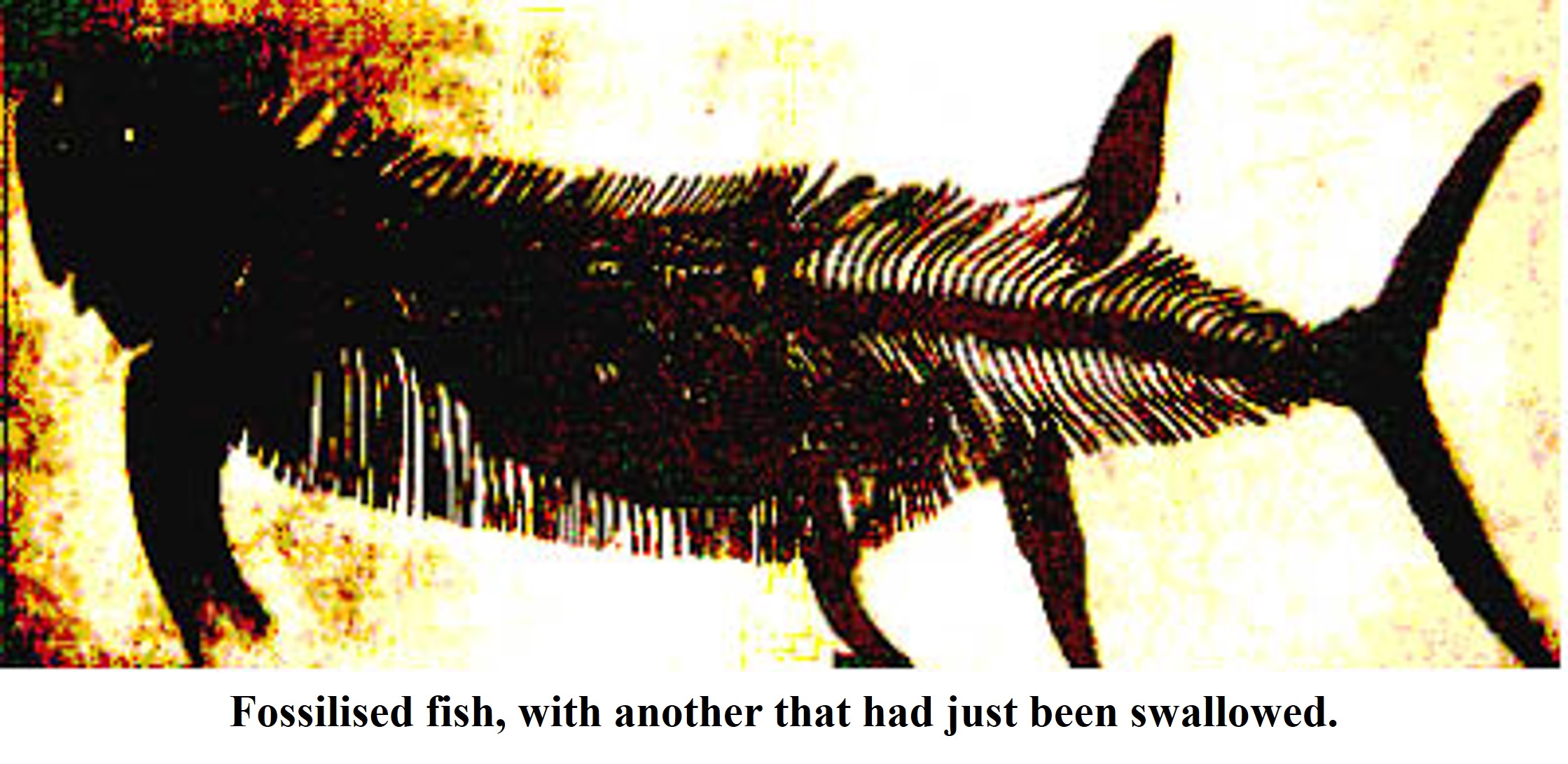
What these findings suggest is that rather than fossilisation being a gradual process in which creatures over millions of years get covered by sediment, it was a sudden, catastrophic event. This event must have involved huge movements of water, which produced the sediments in which the fossils were entombed. This movement could also have resulted in a certain amount of sorting of the creatures on the basis of size or habitat.
Reference
31 Notably in the Burgess shale deposits in the Canadian Rockies.
MORE EVIDENCE FOR CATASTROPHE
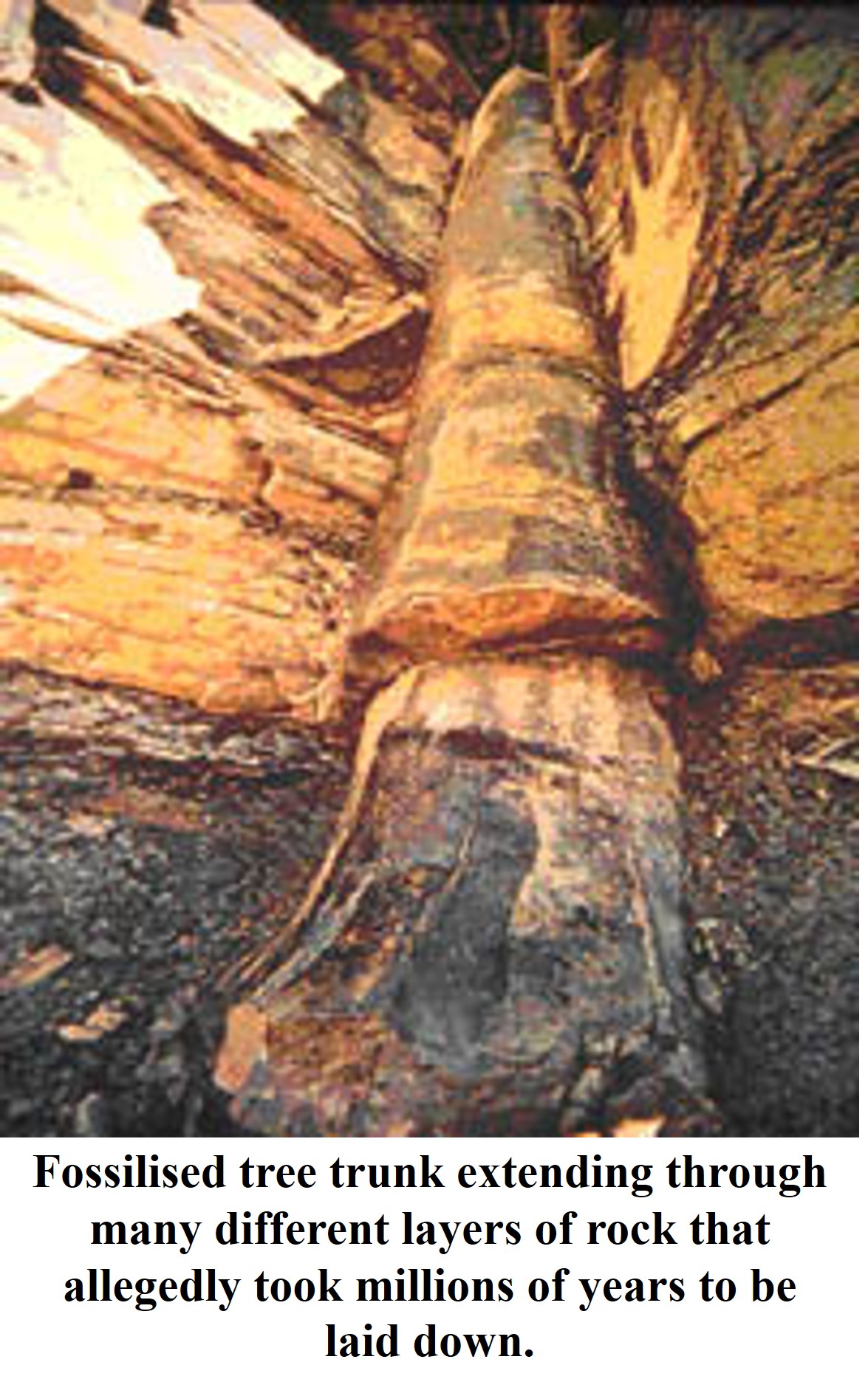
On current geological theories, the sediments that later turned to rock were laid down very slowly over a long period. Average amounts of 0.2 millimetres per year are suggested by some geologists – the thickness of a human hair. This could not be the process by which fossils were formed. As one writer has pointed out, 0.2 millimetres deposit per year would not bury a tadpole, let alone a dinosaur! 32
In some deep coal measures in Germany were found the perfectly preserved fossil remains of thirty-nine iguanadon dinosaurs. These creatures stood several metres high, and it is inconceivable that they just remained on the spot where they died. The coal-forming measures gradually built up around them over millions of years.
Virtually whole tree trunks, some complete with roots, have also been found upright in stone quarries in Scotland and Germany. These extend up through strata that allegedly took millions of years to lay down. Is it reasonable to suggest that the tree trunk was preserved in an upright position without decay for all that time? Such a fossil tree trunk is on display in the garden of the Natural History Museum in London. Another was found in Lancashire, England and was no less than thirty-eight feet tall.33 All this indicates that the trees were suddenly buried.
Reference
33 F.M. Broadhurst: 1965.
NO MISSING LINKS
According to the evolutionary theory, the transition from one form of creature to another was a very gradual process, a particular characteristic developing over a very long period of time. To take a simple example, the giraffe’s long neck would have grown slightly longer over very many generations, until after millions of years it reached the length it is today. Thus for every single fossil of a long-necked giraffe there should be hundreds with a neck of some intermediate length. And the same should apply to all other animals: the missing links should be more numerous than those creatures at the beginning and end of the long chain. In the case of a transition from one type of creature to an entirely different one – for example, a reptile to a bird – then these missing links should be even more in evidence. Nevertheless, these intermediates are just not there.
From the outset, the absence of these intermediate forms has been recognised as one of the major objections to the theory of evolution. In his ‘Origin of Species’ Darwin wrote: ‘As by this theory innumerable transitional forms must have existed, why do we not find them embedded in countless numbers in the crust of the earth?’ He agrees that this absence of intermediate fossils is ‘probably the gravest and most obvious of all the many objections which may be urged against my views’; and that ‘he who rejects this view of the imperfection of the geological record, will rightly reject the whole theory.’ However, he was confident that, with increased geological exploration, those intermediate forms would turn up. But since then, although the fossils of over 250,000 different species of plants and animals have been found, no such definitely transitional forms have been unearthed. Darwin’s ‘grave objection’, with its implicit rejection of his whole theory, still applies today. As one geologist says: ‘We are now about 120 years after Darwin and the knowledge of the fossil record has been greatly expanded. We now have a quarter of a million fossil species, but the situation hasn’t changed much. We have even fewer examples of evolutionary transition than we had in Darwin’s time.’ 34
Reference
34 D.M.Raup: ‘Conflicts between Darwin and Paleontology’,Bulletin, Museum of Natural History (January 1979): 22,25.
BIRDS OF A FEATHER
This is particularly true of the supposed development of flight. According to evolution, flight has developed in at least four independent situations: in birds, insects, flying mammals and flying reptiles (now extinct). Each separate development would have involved numerous transitional forms, subtly changing over millions of years, but no such fossils have been found.
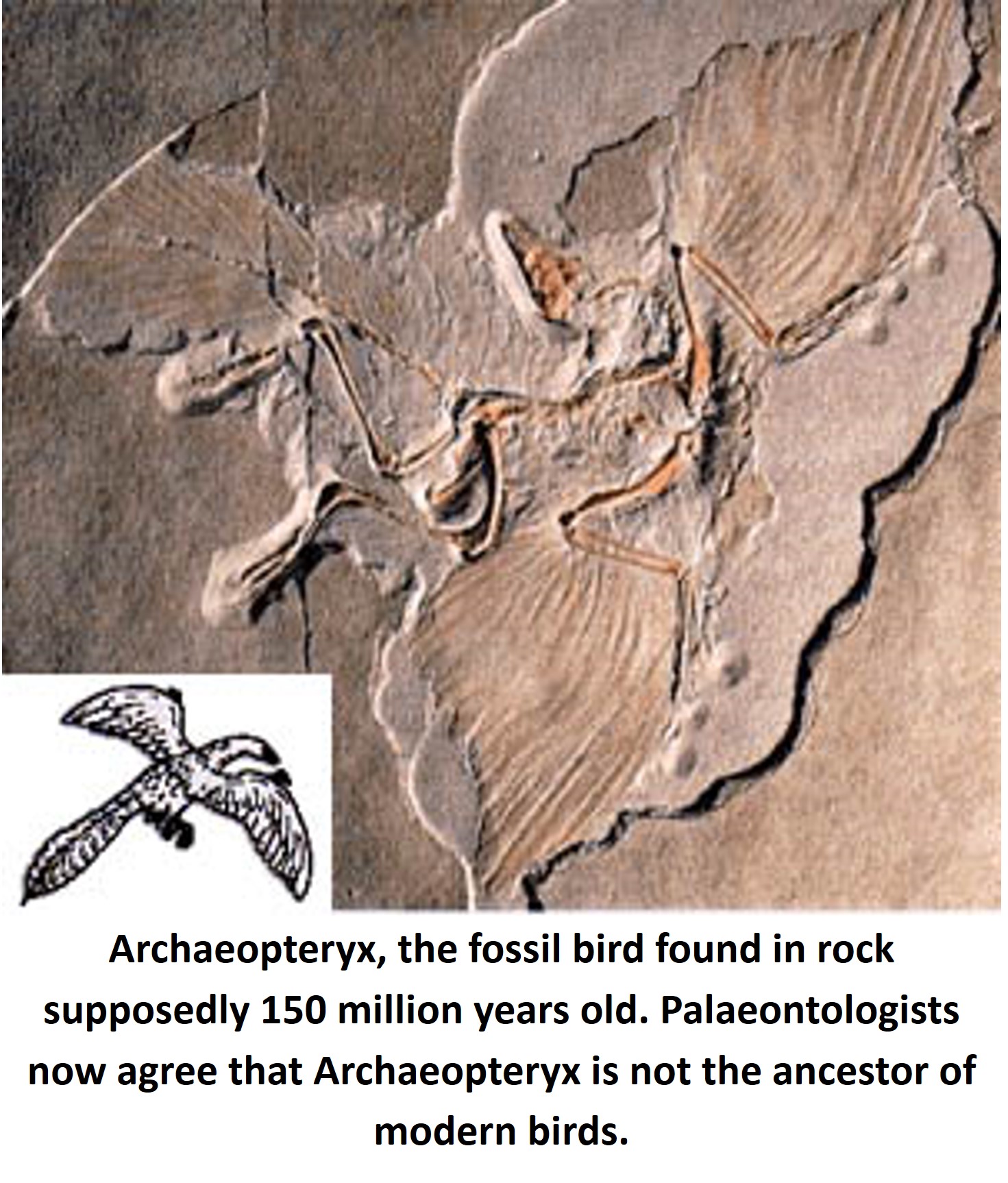
Instead there are just a few fossils which are alleged to represent a transitional form. Probably the most notable is Archaeopteryx, a fossil bird claimed as a link between reptiles and birds. The pictures show the fossil and an artist’s reconstruction. It is bird-like in that it has wings and feathers; but hooks on its wings, teeth in its beak, bones in its tail and the absence of a prominent breastbone are taken as reptilian features.
Archaeopteryx, the fossil bird found in rock supposedly 150 million years old. Palaeontologists now agree that Archaeopteryx is not the ancestor of modern birds.
Nevertheless, there are true birds living today with some of these features. The young hoatzin bird of South America has claws on its wings, as do the turaco and ostrich in Africa. Modern birds do not possess teeth but some fossils that were undoubtedly true birds, do. But the greatest evidence against Archaeopteryx is that not long ago, in the very same rock strata in which it was found, a fossil of a true bird was unearthed.35 Thus, Archaeopteryx could not be the progenitor of true birds for they were already in existence. Archaeopteryx, although admittedly rather odd, was a bird, not a missing link with reptiles.
Doubts are now cast upon Archaeopteryx as a ‘missing link’ between reptiles and birds. In 1985 University of Kansas’s palaeontologist Larry Martin admitted that Archaeopteryx is not ancestral to any group of modern birds. As one modern biologist has said: ‘The almost perfect link between reptiles and birds has been quietly shelved, and the search for missing links continue as though Archaeopteryx has never been found’ 36
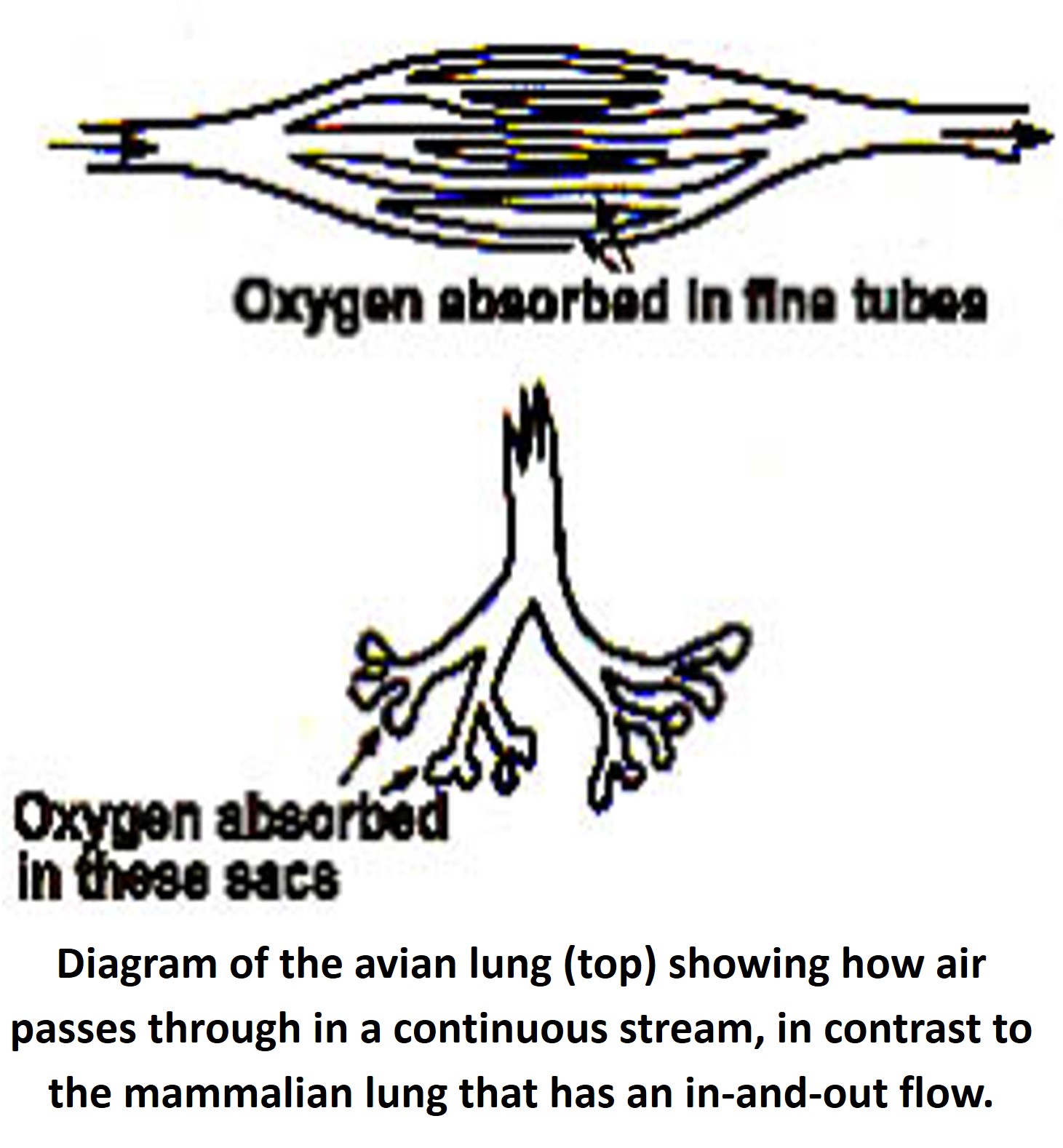
What is fatal evidence against the reptile-to-bird theory is the profound difference in the lungs of the two creatures. In reptiles, as in humans, air is drawn into the lung and is then breathed out the same way as it came in. Birds do not have this in-and-out method. Their lungs are open-ended, the air coming into the lungs by one tube, which divides into smaller ones. These then unite again to form a tube by which the air leaves. Thus there is a continual one-way flow of air through avian lungs. This also necessitates the presence of many other related structures for this method to function.
If birds have come from reptiles how could such radical changes have occurred (by chance mutations, remember!) over millions of years. How would the creature survive whilst the airway direction was being so radically altered? Would chance at the same time produce the other essential altered respiratory structures essential for the bird’s survival? These are the sort of questions for which evolution has no reasonable answer.
Reference
36 J Wells: Icons of Evolution: Science or Myth? 2000, pages 116,135.
HORSE EVOLUTION
Another fossil series taken as a proof of evolution and widely illustrated in books about evolution, is the development of the horse. A small, three-toed creature, supposedly living about sixty million years ago, gradually enlarged one of its toes until it became a hoof. Many books depict a fossil sequence showing the various changes leading up to the modern horse. But, as with the peppered moth story discussed in the previous section (see page 30), this fossil sequence has been shown, even by evolutionists themselves, to be seriously flawed. Just placing a series of fossils in a certain sequence does not prove that evolution occurred, especially if, as in this case, the dating of the fossils was done on the basis of an evolutionary time scale. As one candid evolutionist said of the diagrams showing horse evolution: ‘At present, however, it is a matter of faith that the textbook pictures are true, or even if they are the best representations of the truth available to us at the present time’ He goes on to speak of the pattern of horse evolution as ‘chaotic.’ 37
Another writer highlights the subjective nature of the alleged sequence: ‘However, the fact is that the family tree of the horse is continuous only in the textbooks. At no place in the world do the rock strata disclose a continuous and complete set of horse fossils … The sequence depends on arranging fossils together from all over the world, and since we have learned that rocks are only classified by the fossils they contain, the entire family tree is an entirely subjective arrangement.’ 38
References
37 G.A. Kerkut: Implications of Evolution, 1960, pages 144-149.
38 N.J. Mitchell: Evolution and the Emperor’s New Clothes, page 137.
THE ‘CAMBRIAN EXPLOSION’
In the rocks dated by most geologists as being over 600 million years old – the pre-Cambrian rocks – there is only a smattering of fossilised multicellular creatures. Yet in the Cambrian rock series immediately above it, complex animals appear and life abounds in huge variety.
On the basis of shared characteristics, living things are grouped by biologists into major divisions, called phyla. For example the phylum Insecta includes all the insects and Crustacea includes the crabs, shrimps, etc. At present there are twenty-four different animal phyla and of those, no less than fifteen are represented in the Cambrian rocks. As there are no such fossils in the rocks immediately below the Cambrian strata, it means that fifteen groups of animals apparently suddenly appeared on earth. Therefore, if the rocks tell us anything, they deny that there was a process of gradual evolution but rather an explosion of life in all its fully formed diversity, where virtually no creatures were before.
Charles Darwin was the first to acknowledge the difficulty this presented for his theory. In ‘The Origin of Species’ he said: ‘To the question why we do not find rich fossiliferous deposits…prior to the Cambrian system, I can give no satisfactory answer…the difficulty of assigning any good reason for the absence of vast piles of strata rich in fossils beneath the Cambrian system is very great.’
The problem has not gone away in the intervening years. The ‘Cambrian explosion’, as it is termed, has always been a major problem for evolutionists and many rather bizarre theories have been advanced in order to explain it – except, of course, the suggestion that evolution did not occur! That would be unthinkable!
SUMMARY
Despite many claims by scientists – claims that regrettably are passively accepted by most people – the geological evidence for evolution is very weak. Fossils are present in abundance, but there are basic flaws in the methods of dating the rocks in which they are found. It is evident that fossils were most likely not formed by a gradual process of sedimentation, but by a sudden catastrophic flooding with water-borne sediments. We also saw that in the fossil record, complex forms of life suddenly appeared, with a very wide range of creatures being immediately represented. It is significant that both these activities – creation where no life existed before and a world-wide flood – are prominent aspects of the Bible’s record.
Geology provides no proven ‘missing links’ between the different sorts of animals, which should be there in great numbers if transition from one sort of creature to another gradually took place. Darwin admitted that the absence of such intermediate fossil forms was a major, if not conclusive, argument against his theory. Also the few examples of ‘evolution in action’ that are regularly put forward as evidence of evolutionary change either prove nothing of the sort or are readily capable of other interpretations.
GOD THE CREATOR
Such fallibility in the main buttress of evolution – for all admit that the theory stands or falls on the fossil record. It means that the only reasonable explanation for the presence of life on earth is that stated in God’s own revelation to mankind:
‘I have made the earth, the man and the beast that are upon the ground, by my great power and by my outstretched arm’ [Jeremiah 27.5].
But more than that, if God did create the earth and life upon it, He must have done so for a reason. Here is the great difference between evolution and creation. Evolution is by definition purposeless: each generation of living creatures are but a link in a chain that stretches back into obscurity and extends forward into a completely capricious future. There is no purpose in anything, and no hope for the future.
On the other hand, creation demands a purpose, and with such a wise and powerful Supreme Being in control we can be sure that His plan for His creation is one that will be truly worthwhile. This is the topic of our last section.
![]()
